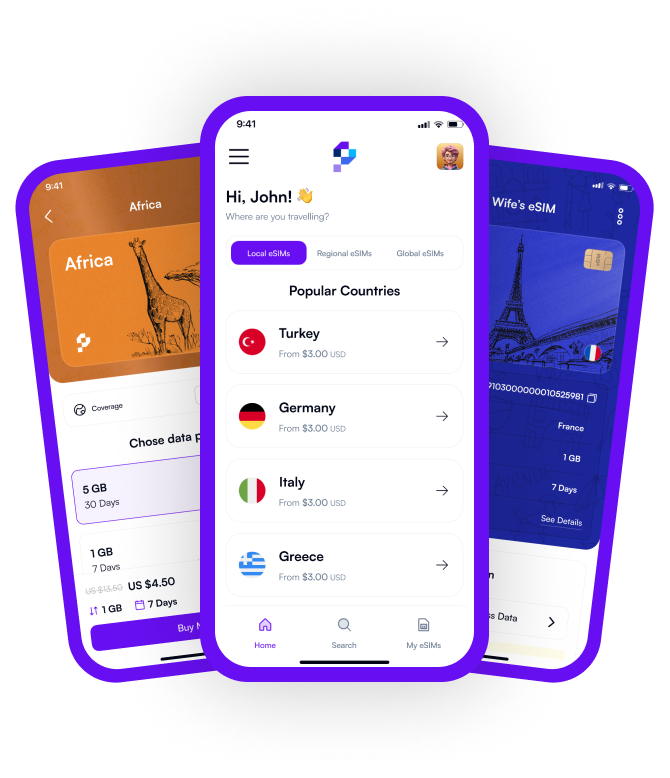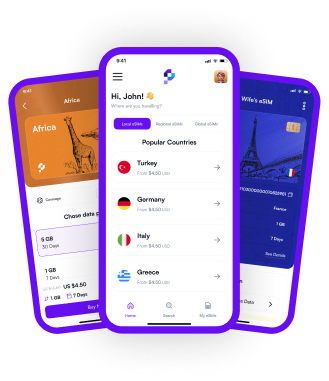When traveling abroad, many people worry about mobile data usage. Roaming charges can be quite high, and it’s easy to end up with a hefty bill without realizing it. However, with eSIM technology, this issue has largely been resolved. Now, you can take advantage of affordable and flexible data plans without the need for local SIM cards or expensive roaming plans while traveling. But how can you control and optimize your internet usage abroad with an eSIM? In this post, we’ll focus on the factors that affect your data consumption abroad, how to monitor and control your usage, and the role eSIM plays in this process.
Factors Affecting Your Data Usage Abroad
Several factors determine how much data you use while traveling abroad. The most common factors include:
- App Usage: Different apps consume different amounts of data, such as video streaming, music listening, social media apps, and messaging services. For instance, watching an hour of HD video consumes about 1-3 GB of data, whereas listening to music for the same amount of time might only use around 150 MB.
- Background App Data: Many apps continue using data in the background. For example, your email accounts may constantly sync new emails, or social media apps may automatically download new content.
- Navigation Apps: Commonly used while traveling, map and navigation apps can also increase your data consumption. Apps like Google Maps use data for every direction and map view. However, using offline maps can be a good way to reduce data usage.
- Wi-Fi Connections: Using Wi-Fi at hotels, restaurants, or cafes can help you minimize data usage. However, when Wi-Fi is unavailable or its security is uncertain, switching to mobile data is often inevitable.
Optimizing Your Data Usage with eSIM
Using an eSIM is one of the most effective ways to optimize data usage while traveling. Without the hassle of traditional SIM card changes, you can load multiple data plans with eSIM and easily activate local plans when traveling to different countries. Additionally, you can control and optimize your data usage by following these steps:
- Use Data Saver Modes: Both Android and iOS devices offer data saver modes that limit background data usage, helping to reduce overall internet consumption. This is especially useful when you have a limited data plan while abroad.
- Manage App Permissions: Control which apps can use mobile data. For instance, you can set high-data-consuming apps, like social media and video streaming apps, to only work on Wi-Fi.
- Use Offline Content: Many video or music streaming apps allow you to download content for offline use. You can download necessary content before your trip to minimize mobile data usage.
- Track Your Data Usage: Monitor your data usage through your phone’s settings, where you can see how much data each app consumes. This allows you to manage your data plan more effectively.
- Switch to Local Data Plans: With eSIM technology, you can easily load local data plans for the country you're traveling to. For example, if you’re traveling to Europe, you can load an eSIM plan valid across Europe, allowing you to use the internet at much lower rates than traditional roaming. With Pocket eSIM's flexible data plans, you can choose the most suitable local data plan for your destination and save significantly on data costs abroad.
How Much Data Do You Use Abroad?
Your internet usage depends on your travel habits and the apps you use. Here are some estimates for common apps and activities:
- Social Media Usage: Sharing photos or videos consumes an average of 10 MB to 50 MB. Browsing your social media feed for about 10 minutes can consume approximately 100-150 MB of data.
- Video Streaming (Netflix, YouTube): Streaming standard quality video uses about 1 GB per hour, while HD quality can consume up to 3 GB per hour. If you plan to watch videos on long trips, it’s best to use Wi-Fi or download videos for offline viewing.
- Navigation (Google Maps): Using navigation for about an hour consumes around 5 MB to 10 MB. However, getting directions might use slightly more data.
- Music Streaming (Spotify, Apple Music): On average, a music streaming app uses 1 MB of data per minute. This means listening to music for an hour will consume around 60 MB of data.
- Video Calls (Zoom, FaceTime): Standard-quality video calls use between 5 MB and 10 MB per minute. A one-hour video call will consume around 300-600 MB of data.
Data Plans with Pocket eSIM
Pocket eSIM provides travelers with affordable internet access in the countries they visit. With just a few steps, you can activate Pocket eSIM and stay connected in different countries. Controlling your data usage while traveling abroad allows you to reduce your costs and enjoy seamless connectivity.
You can learn more about how Pocket eSIM works by visiting the how it works page, and check which devices are compatible by viewing the compatibility page.
Conclusion: Travel Worry-Free with eSIM
Using the internet while traveling abroad is now much easier and more affordable than ever. With flexible and affordable data plans provided by Pocket eSIM, you can monitor your internet consumption, optimize your costs, and stay connected at all times. By managing your data plan wisely, you can enjoy a seamless and hassle-free travel experience.

